第四章2 句子的英译-语序的调整及否定句的英译 翻译理论方法
- 格式:pdf
- 大小:368.82 KB
- 文档页数:17
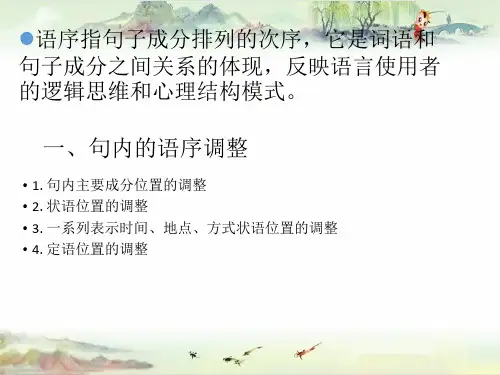
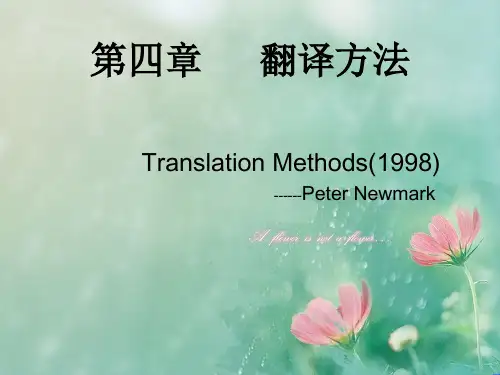
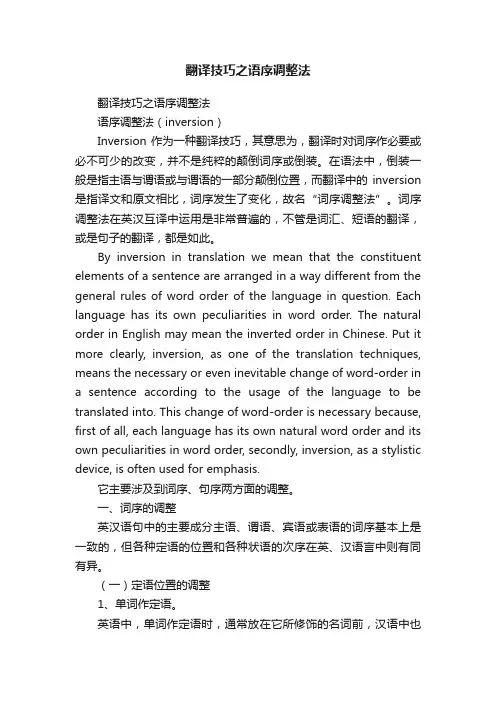
翻译技巧之语序调整法翻译技巧之语序调整法语序调整法(inversion)Inversion 作为一种翻译技巧,其意思为,翻译时对词序作必要或必不可少的改变,并不是纯粹的颠倒词序或倒装。
在语法中,倒装一般是指主语与谓语或与谓语的一部分颠倒位置,而翻译中的inversion 是指译文和原文相比,词序发生了变化,故名“词序调整法”。
词序调整法在英汉互译中运用是非常普遍的,不管是词汇、短语的翻译,或是句子的翻译,都是如此。
By inversion in translation we mean that the constituent elements of a sentence are arranged in a way different from the general rules of word order of the language in question. Each language has its own peculiarities in word order. The natural order in English may mean the inverted order in Chinese. Put it more clearly, inversion, as one of the translation techniques, means the necessary or even inevitable change of word-order in a sentence according to the usage of the language to be translated into. This change of word-order is necessary because, first of all, each language has its own natural word order and its own peculiarities in word order, secondly, inversion, as a stylistic device, is often used for emphasis.它主要涉及到词序、句序两方面的调整。
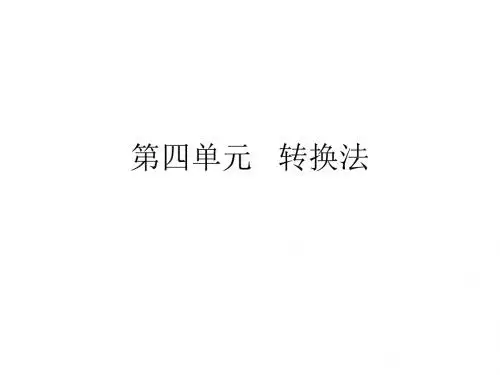
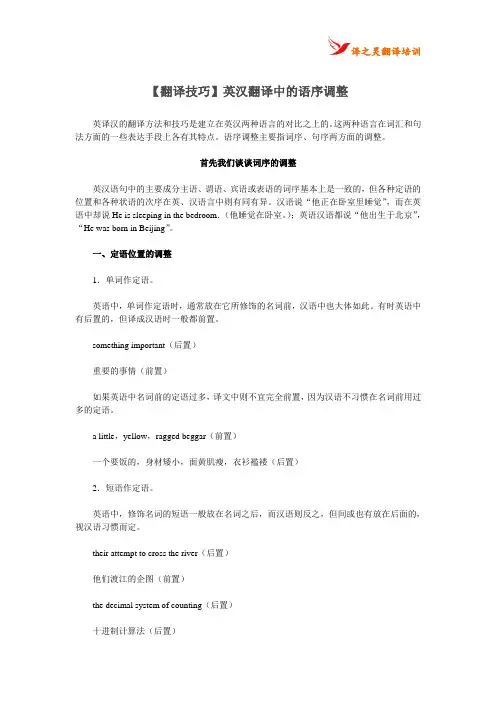
【翻译技巧】英汉翻译中的语序调整英译汉的翻译方法和技巧是建立在英汉两种语言的对比之上的。
这两种语言在词汇和句法方面的一些表达手段上各有其特点。
语序调整主要指词序、句序两方面的调整。
首先我们谈谈词序的调整英汉语句中的主要成分主语、谓语、宾语或表语的词序基本上是一致的,但各种定语的位置和各种状语的次序在英、汉语言中则有同有异。
汉语说“他正在卧室里睡觉”,而在英语中却说He is sleeping in the bedroom.(他睡觉在卧室。
);英语汉语都说“他出生于北京”,“He was born in Beijing”。
一、定语位置的调整1.单词作定语。
英语中,单词作定语时,通常放在它所修饰的名词前,汉语中也大体如此。
有时英语中有后置的,但译成汉语时一般都前置。
something important(后置)重要的事情(前置)如果英语中名词前的定语过多,译文中则不宜完全前置,因为汉语不习惯在名词前用过多的定语。
a little,yellow,ragged beggar(前置)一个要饭的,身材矮小,面黄肌瘦,衣衫褴褛(后置)2.短语作定语。
英语中,修饰名词的短语一般放在名词之后,而汉语则反之,但间或也有放在后面的,视汉语习惯而定。
their attempt to cross the river(后置)他们渡江的企图(前置)the decimal system of counting(后置)十进制计算法(后置)二、状语位置的调整1.单词作状语。
英语中单词作状语修饰形容词或其他状语时,通常放在它所修饰的形容词或状语的前面,这一点与汉语相同。
He was very active in class.(前置)他在班上很活跃。
(前置)英语中单词作状语修饰动词时,一般放在动词之后,而在汉语里则放在动词之前。
Modern science and technology are developing rapidly.(后置)现代科学技术正在迅速发展。
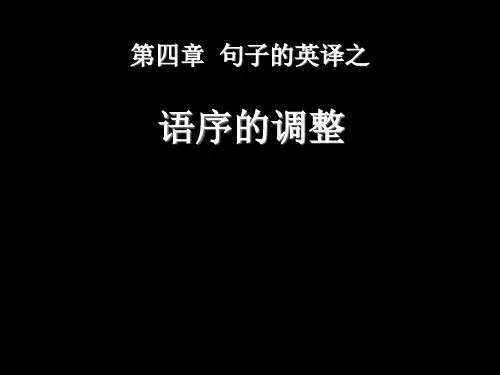

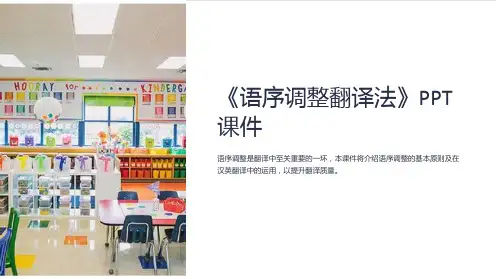

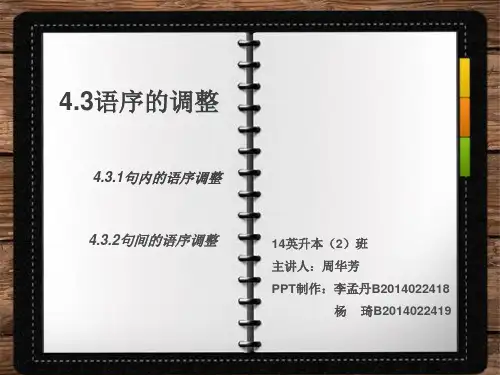
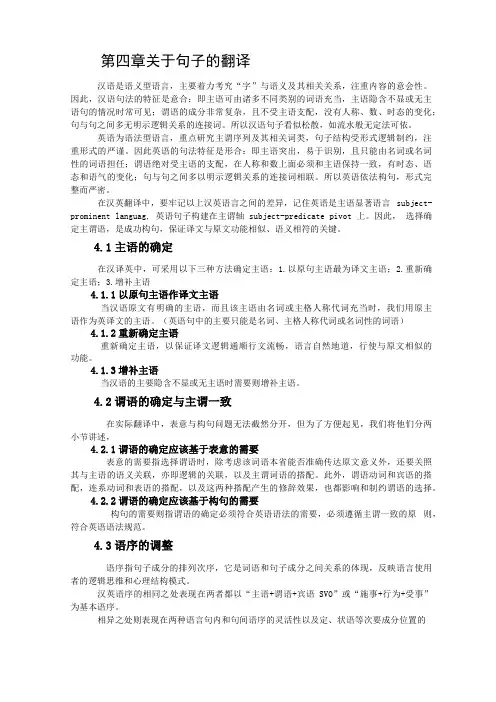
第四章关于句子的翻译汉语是语义型语言,主要着力考究“字”与语义及其相关关系,注重内容的意会性。
因此,汉语句法的特征是意合:即主语可由诸多不同类别的词语充当,主语隐含不显或无主语句的情况时常可见;谓语的成分非常复杂,且不受主语支配,没有人称、数、时态的变化;句与句之间多无明示逻辑关系的连接词。
所以汉语句子看似松散,如流水般无定法可依。
英语为语法型语言,重点研究主谓序列及其相关词类,句子结构受形式逻辑制约,注重形式的严谨。
因此英语的句法特征是形合:即主语突出,易于识别,且只能由名词或名词性的词语担任;谓语绝对受主语的支配,在人称和数上面必须和主语保持一致,有时态、语态和语气的变化;句与句之间多以明示逻辑关系的连接词相联。
所以英语依法构句,形式完整而严密。
在汉英翻译中,要牢记以上汉英语言之间的差异,记住英语是主语显著语言subject-prominent languag, 英语句子构建在主谓轴 subject-predicate pivot 上。
因此,选择确定主谓语,是成功构句,保证译文与原文功能相似、语义相符的关键。
4.1主语的确定在汉译英中,可采用以下三种方法确定主语:1.以原句主语最为译文主语;2.重新确定主语;3.增补主语4.1.1以原句主语作译文主语当汉语原文有明确的主语,而且该主语由名词或主格人称代词充当时,我们用原主语作为英译文的主语。
(英语句中的主要只能是名词、主格人称代词或名词性的词语)4.1.2重新确定主语重新确定主语,以保证译文逻辑通顺行文流畅,语言自然地道,行使与原文相似的功能。
4.1.3增补主语当汉语的主要隐含不显或无主语时需要则增补主语。
4.2谓语的确定与主谓一致在实际翻译中,表意与构句问题无法截然分开,但为了方便起见,我们将他们分两小节讲述,4.2.1谓语的确定应该基于表意的需要表意的需要指选择谓语时,除考虑该词语本省能否准确传达原文意义外,还要关照其与主语的语义关联,亦即逻辑的关联,以及主谓词语的搭配。
中译英语序调整法中译英语序调整法是一种翻译技巧,涉及到主语、谓语、宾语、介词、状语、定语、语态和时态等八个方面的调整。
下面将对每个方面进行详细介绍。
1. 主语调整在中文原句中,主语的位置通常在句子的开头。
而在英语中,主语的位置则不一定。
因此,在进行中译英翻译时,需要根据英语表达习惯对主语的位置进行调整。
例如:中文原句:他很努力地工作。
英语译文:Working very hard, he was able to complete the task.在这个例子中,中文原句的主语是“他”,放在了句子的开头。
而在英语译文中,主语“Working very hard”被放在了句子的中间,这样的调整更符合英语表达习惯。
2. 谓语调整在中文原句中,谓语的位置通常紧随主语之后。
而在英语中,谓语的位置则不一定。
因此,在进行中译英翻译时,需要根据英语表达习惯对谓语的位置进行调整。
例如:中文原句:他喜欢看电影。
英语译文:He enjoys watching movies.在这个例子中,中文原句的谓语是“喜欢”,放在了主语“他”之后。
而在英语译文中,谓语“enjoys”放在了主语“He”的前面,这样的调整更符合英语表达习惯。
3. 宾语调整在中文原句中,宾语的位置通常在谓语之后。
而在英语中,宾语的位置则不一定。
因此,在进行中译英翻译时,需要根据英语表达习惯对宾语的位置进行调整。
例如:中文原句:我看了一本书。
英语译文:I read a book.在这个例子中,中文原句的宾语是“一本书”,放在了谓语“看”之后。
而在英语译文中,宾语“a book”放在了谓语“read”的前面,这样的调整更符合英语表达习惯。
4. 介词调整在中文原句中,介词的位置通常在宾语之前。
而在英语中,介词的位置则不一定。
因此,在进行中译英翻译时,需要根据英语表达习惯对介词的位置进行调整。
例如:中文原句:我在学校学习。
英语译文:I study at school.在这个例子中,中文原句的介词是“在”,放在了宾语“学校”之前。